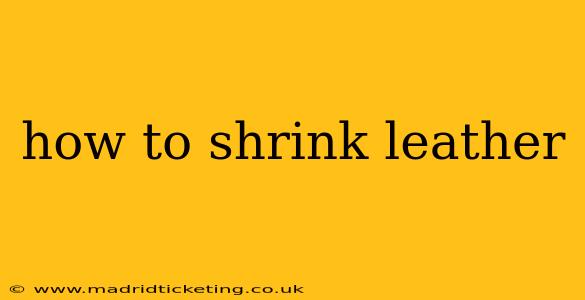Leather, a luxurious and durable material, can sometimes require shrinking to achieve a desired fit, repair damage, or create a specific aesthetic. Whether you're working with a leather jacket that's become too large, a piece of leather craft that needs tightening, or simply experimenting with leather manipulation, understanding how to shrink leather effectively is key. This guide explores various methods and considerations for shrinking leather successfully.
What Causes Leather to Stretch?
Before diving into shrinking techniques, it's important to understand why leather stretches in the first place. Leather is a natural material, and its elasticity is influenced by several factors:
- Type of Leather: Full-grain leathers are generally more resistant to stretching than corrected-grain or top-grain leathers.
- Moisture: Exposure to water or excessive humidity can cause leather to expand.
- Wear and Tear: Consistent use and stress can gradually stretch leather over time.
- Manufacturing Process: The tanning and finishing processes can impact the final elasticity of the leather.
How to Shrink Leather: Different Methods
Several methods can shrink leather, each with varying degrees of effectiveness and suitability depending on the type of leather and the desired outcome. Let's explore some of the most common techniques:
1. Using Heat
Heat is perhaps the most widely used method for shrinking leather. It works by causing the collagen fibers within the leather to contract. However, be cautious; excessive heat can damage the leather, causing it to become brittle or crack.
- Steam: Gently steaming leather can cause it to shrink slightly. Use a steamer cautiously, keeping it a safe distance from the leather to avoid burning or scorching.
- Ironing: With low heat and a damp cloth between the iron and the leather, carefully iron the leather to encourage shrinking. Test a small, inconspicuous area first.
- Hair Dryer: Using a hair dryer on a low setting and holding it a few inches away, you can gently apply heat to specific areas. Again, test a small area first.
2. Using Water
Water can also be used to shrink leather, but it's crucial to control the amount of moisture and avoid over-saturation. Too much water can cause the leather to become stiff and damaged.
- Soaking and Drying: Lightly dampen the leather and allow it to air dry naturally. This method is generally better suited for smaller leather pieces or sections. Avoid direct sunlight during drying as this can cause discoloration and cracking.
3. Combining Heat and Water
A more effective approach often involves combining heat and water. This synergistic approach often leads to more significant shrinkage than using either method alone.
4. Professional Leather Shrinkage
For delicate or valuable leather items, consider seeking professional help. A skilled leatherworker possesses the expertise and tools to shrink leather effectively without damaging it.
How Much Can You Shrink Leather?
The amount of shrinkage achievable varies considerably depending on the leather's type, thickness, and the method used. You can expect only minimal shrinkage with methods such as steaming, while more aggressive techniques, like soaking and controlled drying, may yield more substantial results. Always proceed cautiously and test your chosen method on a hidden area first.
Can You Shrink Leather Without Damaging It?
Yes, you can shrink leather without damaging it, provided you use the appropriate method and exercise caution. The key is to avoid extreme temperatures, excessive moisture, and harsh chemicals. Always start with a gentle approach and carefully monitor the leather's reaction.
What Type of Leather Shrinks Best?
Full-grain leather generally shrinks more effectively than other types of leather because its fibers are less processed. However, even full-grain leather's response to shrinking techniques will vary depending on the tanning and finishing processes.
Conclusion
Shrinking leather requires a delicate balance of heat and moisture, and caution is paramount. By understanding the different methods and exercising patience, you can successfully shrink leather to achieve the desired results, whether it's restoring a favorite jacket, crafting a new project, or simply experimenting with this versatile material. Remember to always test on a hidden area first before attempting any method on the whole piece.

